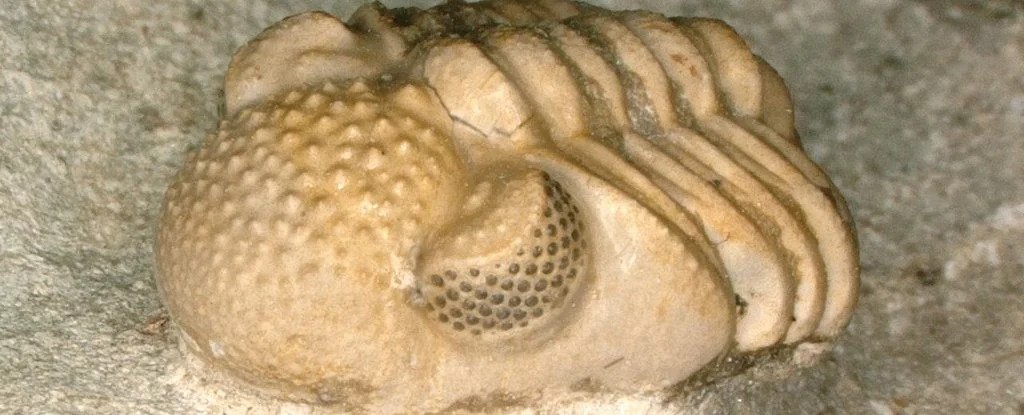Primordial “Hyper-Eye” Discovered: Astonishing 390 Million-Year-Old Hyper-Compound Eye With 200 Lenses
A fossilized trilobite first studied by an amateur palaeontologist half a century ago has provided researchers with a whole new way of seeing the world, in a very literal sense. X-rays taken of the ancient arthropod back in the early 1970s have been given a second look, revealing a structure of an eye that is unlike any seen on any animal before or since.

As head of Siemens radiology department, Wilhelm Stürmer knew a thing or two about using X-rays to reveal hidden secrets. This was especially true when it came to studying fossils, a passion he fueled by fitting out a minibus with X-ray equipment to take out to palaeontology sites. In spite of his expertise in radiology, Stürmer wasn’t a palaeontologist, so few took his claim of discovering optic nerves inside a 390-million-year-old Phacops geesops fossil seriously.
“At that time, the consensus was that only bones and teeth, the hard parts of living things, could be seen in the fossils, but not the soft parts, such as intestines or nerves,” says the University of Cologne palaeontologist Brigitte Schoenemann.
In addition to the nerves was an arrangement of ‘fibres’ that looked uncannily like photoreceptor cells called ommatidia. Only in this case, they were strangely elongated, roughly 25 times their own diameter; far too long to seem plausible as a light-gathering structure.
A lot has changed since then. Today, palaeontologists are comfortable with the idea that soft tissue structures can leave a clear signature in fossilized material. And super-long ommatidia have since been uncovered in the compound eyes of aquatic arthropods.
With that in mind, Schoenemann and her colleagues went back to Stürmer’s original images for a closer look. After double-checking the fossil with modern CT technology, they determined the filaments he spotted were almost certainly optic nerve fibres after all.
But it was what the foam-like nest of fibres was connected to that really grabbed the researchers’ attention: What seemed like two compound eyes were actually hundreds, split across left and right clusters.
“Each of these eyes consisted of about 200 lenses up to one millimetre in size,” says Schoenemann.
“Under each of these lenses, in turn, at least six facets are set up, each of which together again makes up a small compound eye. So we have about 200 compound eyes (one under each lens) in one eye.”
Trilobites more or less dominated the oceans for hundreds of millions of years, adapting to fill a broad range of aquatic niches with a variety of weird and wonderful body plans.
One of their most clever inventions was a visual system of unprecedented complexity. While comparably simple in modern terms, their version of eyes gave them the edge in hunting or hiding and in detecting the subtlest of changes in brightness and movement.
Though their eye anatomy came in many forms, the most common structures would be easily recognizable to most zoologists today, consisting of a neatly arranged pattern of lenses working together to turn diffuse light into a heavily pixelated map of their surroundings.
Modern insects and other arthropods continue to rely on compound eyes like these to great effect. What this pixelated view lacks in resolution is easily made up for in simplicity and adaptability, evolving to overcome limitations with a few tweaks of anatomy.
Yet for the incredible diversity of trilobite eyes, those on certain members of the suborder Phacopina have had palaeontologists stumped.
In what’s known as a schizochroal eye, each lens sits a short distance away from its neighbour, leaving a lot of empty space that could be put to use catching more light.
We now know what appears to be a single lens is, in fact, a single compound eye within two ‘hyper-eyes’.
While it doesn’t tell us why these eyes evolved, it does change what questions we need to ask about this unusual arthropod. Rather than pondering the waste of space between each lens, biologists can now speculate over the benefits hundreds of tiny eyes have in adjusting to low light, or responding to rapid changes in light conditions over a wider area.
“It is also possible that the individual components of the eye performed different functions, enabling, for example, contrast enhancement or the perception of different colours,” says Schoenemann.
READ ALSO: SCIENTISTS DISCOVER “ONCE-IN-A-GENERATION” FOSSILIZED WATER BEAR IN 16-MILLION-YEAR-OLD AMBER
Stürmer must have suspected there was something worth looking at in the eyes, having drawn an arrow in red pen pointing right at the half-dozen facets beneath one of the lenses.
Sadly, the radiologist passed away in the 1980s, long before his discovery was given the validation it deserved.
Like the trilobite, Stürmer was clearly a visionary before his time.





